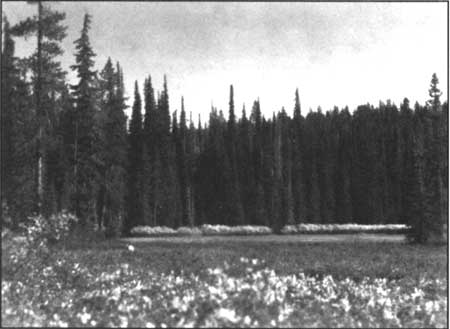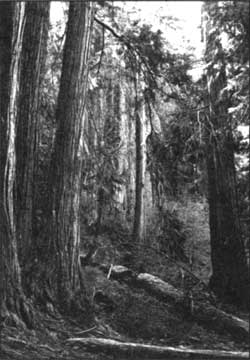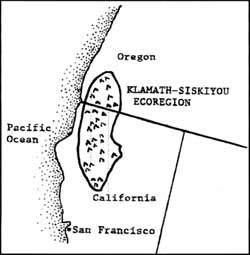Although it is a wetland and therefore fragile, Sphagnum Bog makes an interesting destination for a hike. Several trails go there from locations inside the park, but the shortest way is to take state highway 230 and turn east at the sign for National Creek Falls. Use Rogue River National Forest road 6536 to go east, then spur road 660 to find the trailhead that is only one quarter mile from the park boundary. Anyone familiar with extended walking in dry subalpine forest or through open pumice will appreciate the contrast Sphagnum Bog offers.

Sphagnum Bog. NPS photo, Crater Lake Museum and Archives Collections.
The RNA designation is not aimed at enhancing recreational experience, but the casual visitor can nevertheless gain some appreciation for how each of these areas might contribute to current and future scientific study. Other localities in the park have been focal points for notable botanical and ecological investigations in the past, though areas like the Panhandle and Wizard Island did not score as well in the Nature Conservancy’s evaluation process. Each place has its own peculiar characteristics, with some so distinctive that they can serve as the standard from which to compare various kinds and levels of tinkering.
Steve Mark is a National Park Service historian who has served as editor of Nature Notes since its revival in 1992.
Why So Many Siskiyou Plants?
The Klamath-Siskiyou Ecoregion, hereafter KSE, is an oblong area that extends from Roseburg in southwestern Oregon to the Yolla Bully range in northwestern California. The varied geology, location, and microclimates of the KSE accelerated plant evolution and migration but slowed extinction. At least 3,000 types of plants and all the major forest types in western North America occur here. More than 200 of these plants are KSE endemics, the name for a species found only in a particular area. Oregon Caves National Monument, as a small but important zone of transition in the KSE, illustrates this floral diversity by boasting almost one plant species per acre.1
Geologic controls
Ocean basins were spread apart or squeezed for more than half a billion years while molten magma crystallized into rocks as different as basalt and granite. Erosion and metamorphism created another range of strata as well: sandstone, marble, pebbly conglomerate, glacial silt, and “baked” muds. Faults uplifted and split rock masses apart, changing what once were islands and ocean basins into a complex rock mosaic. This fragmentation of habitat favors small populations on each type of soil or rock, a situation in which mutations that give rise to new species are not diluted out of existence by interbreeding with large populations.
 A stand of Port Orford-Cedar near Oregon Caves. |
Peridotites are rocks with potent quantities of minerals like iron and magnesium that change to metal-rich serpentine when hot water is added. Since most life is not adapted to metals normally found deep in the earth, these metals disrupt photosynthesis and inhibit microbes. The most toxic may be nickel, chromium, and cobalt though plant distribution in the KSE seems to be governed by the occurrence of magnesium. Little soil forms because clays need aluminum, an element lacking in serpentine. This and the toxicity of metals in serpentine will not allow clay, organics, or soil clumps to hold water, The cycle snowballs and becomes a situation where thin soils are often dry, hot, and nutrient-poor. This provides open habitat, increases population turnover, and thus encourages the evolution of new species. Because their populations are smaller, species that are rare usually evolve faster than common and/or widespread plants. Of the 200 endemic plant types in the KSE, 141 are either rare or uncommon, a very high ratio for endemics.
The low productivity of serpentine soils limits the dispersal of endemics to new areas because of fewer pollen grains, seeds, or tall plants. Seeds in serpentine tend to be larger because of being in such stressful habitat, so as to give seedlings a head start on life. This characteristic may also limit dispersal, thus increasing the number of endemics.
The most common response for most plants on serpentine is to keep nickel out of their cells. Even some mariposa lillies and wild buckwheats living on non-serpentine soils tolerate high amounts of normally toxic metals, so they appear better prepared for evolving new species on serpentine soils, Some KSE plants have found other ways to avoid serpentine toxicity. In an endemic pennycress mustard and jewel flower, the plant stores nickel within its cell tissue. Another jewel flower (Streptanthus tortuosus) has developed a race of serpentine-tolerant plants and so may be on its way to becoming a new species.
Rapid evolution is also indicated by the fact that roughly two-thirds of KSE endemics are varieties or subspecies that likely are on their way to becoming full species. The crowding of habitats in the KSE results in many hybrids, some of which have given rise to new species.


